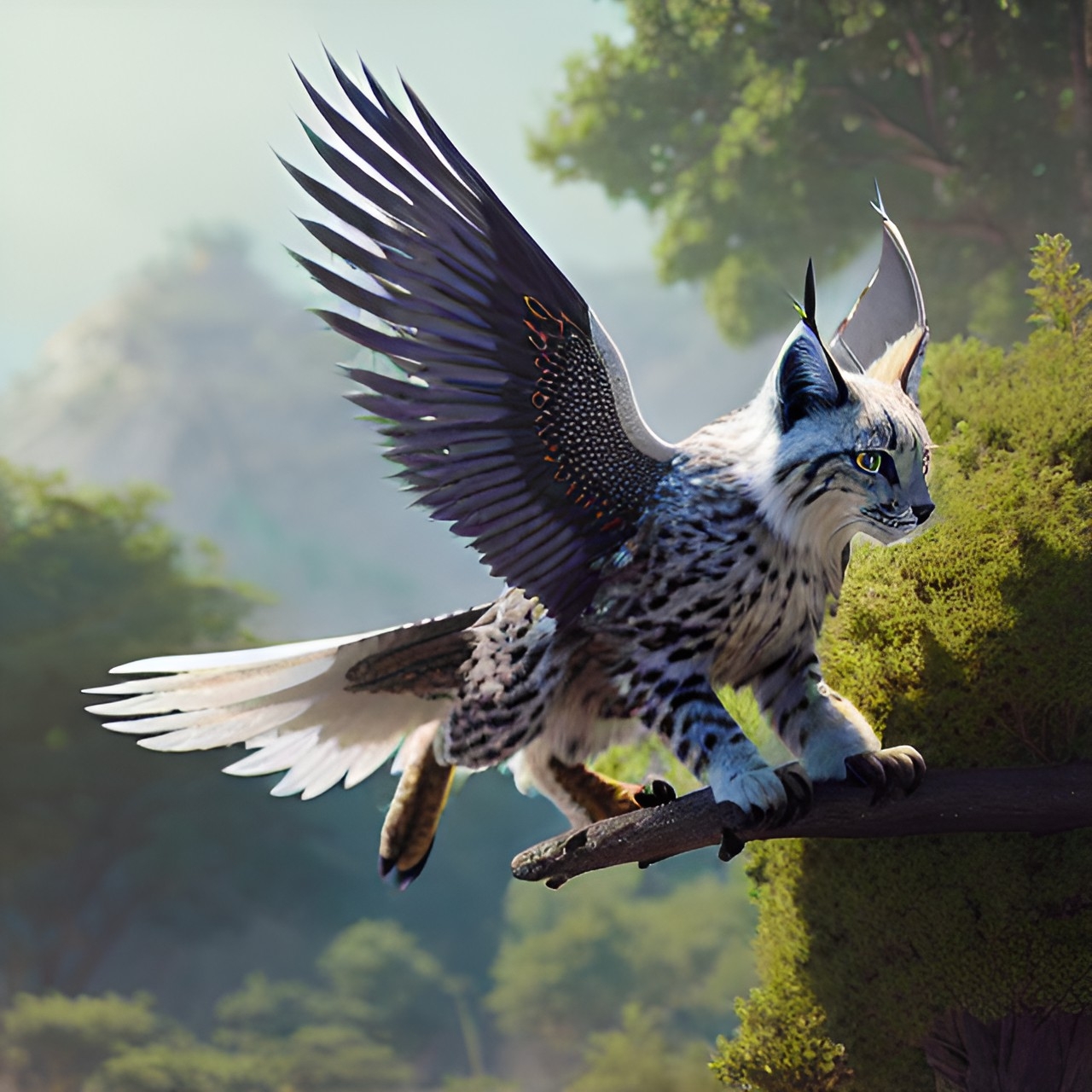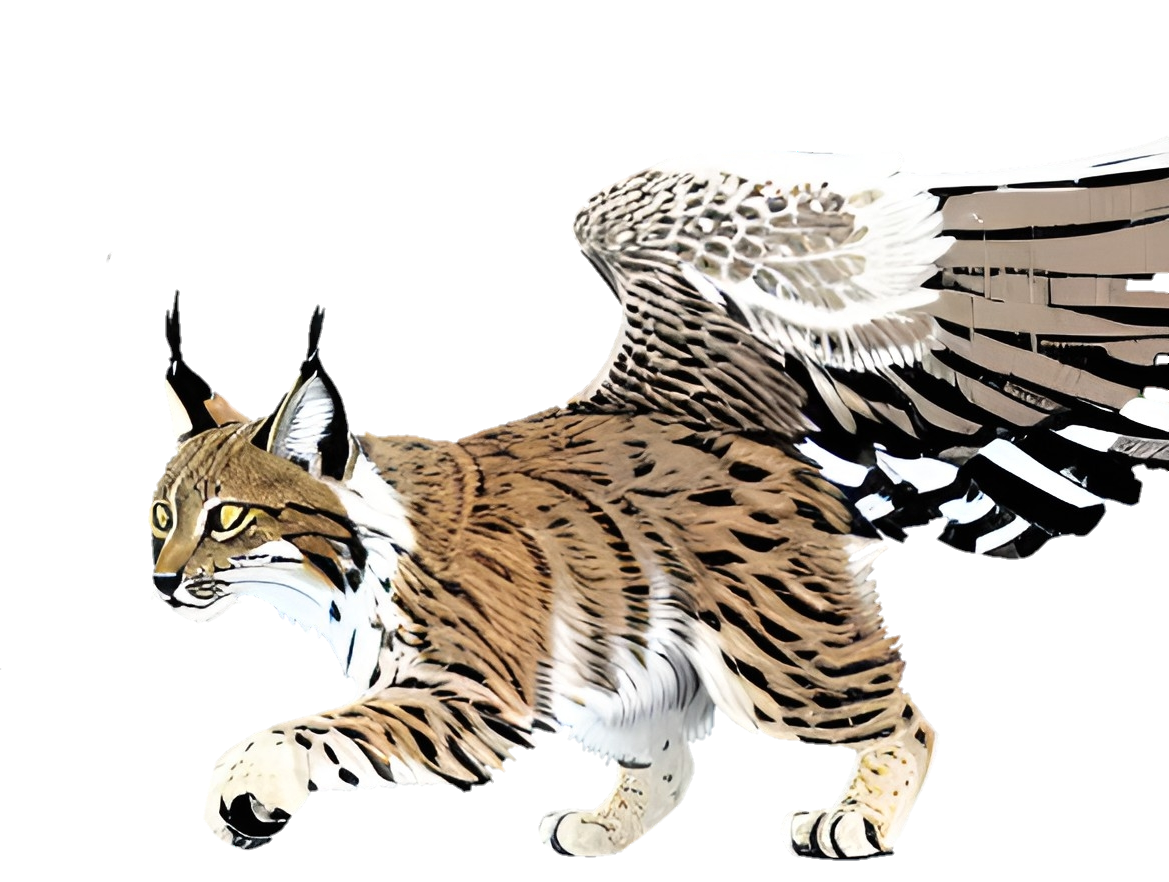Minx
Racial Magic
First Ability
Besida's Form-Merlin
Second Ability
Azowyr's Movement
or
Felryth's Apathy
These beasts live throughout the Tenebrous Chain and are an apex predator of the heathlands and deep forests. There are minx living in Rossiya and Skaney but they aren't as well established. The Minx House of the Ten Houses has this creature on their emblem. The heads of this House possess racial magic which grants them physical attributes of the creature and this family originates from the heathlands as well.
Minx themsevles are known for having a finicky, tenacious and vicious temperament. They are very much like their ancestors, the Eurasian Lynx, but its aerial capabilities and elemental connections have altered their behaviors considerably including taking on behaviors of a merlin falcon. One such change is their tendency to utilize nests, taking those of large birds. These can be observed along the cliff faces of Lacuna Heath where the earth is scarred. They are extremely territorial, even harassing larger species with their incredible agility and talons, as the already territorial behavior of the lynx was only amplified by that of the merlin. They are especially intolerant to other aerial predators. When provoked into fighting, they are quick to shred their opponents, grasping them with their front claws and shredding them with "bunny kicks" using their back talons. They also have a strong bite with particularly long canines.
First Ability
Besida's Form-Merlin
Possesses physical features of a merlin falcon, usually wings and the hindquarters inclluding both talons and tailfeathers. Some may inherit a beak but all gain the exceptional vision of this falcon.
Second Ability
Azowyr's Movement
Able to walk, step or move on or through dark enough shadows regardless of gravity or lack of surfaces. They can even merge with shadows and travel along them briefly, slipping through small spaces with connected shadows! However, shadow magic can actually physically touch them and restrain them.
or
Felryth's Apathy
Able to block a target's access to fear, anxiety or nightmares. This leaves them unable to experience these emotions, thoughts or bad dreams while under this effect. They can also turn off their own fear for a duration.
These beasts live throughout the Tenebrous Chain and are an apex predator of the heathlands and deep forests. There are minx living in Rossiya and Skaney but they aren't as well established. The Minx House of the Ten Houses has this creature on their emblem. The heads of this House possess racial magic which grants them physical attributes of the creature and this family originates from the heathlands as well.
Minx themsevles are known for having a finicky, tenacious and vicious temperament. They are very much like their ancestors, the Eurasian Lynx, but its aerial capabilities and elemental connections have altered their behaviors considerably including taking on behaviors of a merlin falcon. One such change is their tendency to utilize nests, taking those of large birds. These can be observed along the cliff faces of Lacuna Heath where the earth is scarred. They are extremely territorial, even harassing larger species with their incredible agility and talons, as the already territorial behavior of the lynx was only amplified by that of the merlin. They are especially intolerant to other aerial predators. When provoked into fighting, they are quick to shred their opponents, grasping them with their front claws and shredding them with "bunny kicks" using their back talons. They also have a strong bite with particularly long canines.
Basic Information
Anatomy
Eurasian lynx were blessed by Besida, taking on physical attributes of a merlin falcon. It is capable of retaining all lynx features but most minx tend to remain in their magic form. This form generally has merlin wings, hindquarters (including avian legs, tailfeathers and talons) and their eyes take on the abilities of both lynx and merlin eyes. There can be some variation between minx when it comes to these features, sometimes even taking on the head or beak of a merlin instead.
Lynx Half: Like many felines, their front claws are retractable. They generally have reddish and white fur, sometimes with spots and streaks, while the stomach is paler. They have distinct black tufts on their ears and have yellow to green eyes with round pupils (not slitted). They have more reddish coats most of the year, lightening and growing much denser in winter. Their winter coat is also longer and much silkier.They have a round head and short snout. Their skull is structured for eating meat and their canines are particularly long and sharp. However, it does not have the bite force needed to crush bones, instead having a powerful neck and jaw muscles for gripping power. It grows to 70-140 cm in length and weighs 8-25 kg, males larger than females. They are also able to purr!
Merlin Half: Their wings are notably smaller than larger avian species such as eagles. Males have darker blue to gray backs and buff to orange front while females are generally reddish-brown. Both have whitish spots with brown or orange tinted coloration on the front. If the minx has a beak, it is dark with a yellow cere. Their feet are also yellow with black claws. Compared to other falcons, merlins are much heavier and robustly built. Their tail is relatively long and square-cut and broad-based pointed wings, shorter than that of other falcons. They fly with rapid wingbeats with occasional glides and wings held close to their body. They are agile fliers capable of impressive bursts of speed and are particularly prone to tail chasing birds.
Genetics and Reproduction
Like ordinary lynx, they are solitary creatures outside breeding and tend to only interact with their own kind during mating season (early spring/late winter).They can be very vocal during this time, males often engaging in screaming matches over a female. Unlike regular lynx, the minx tend to mate with only one partner, often the same partner each year, and the male will stick around to protect the female during pregnancy and provide food for her and the kittens.
The pair will seek out a nest, often stealing them from large birds or utilizing caves or dens along cliff faces. They can also be seen hunting together during this time. With the hindquarters of a merlin, these creatures actually lay eggs and the kitten will claw its way out when ready. The mother tends to stay with the eggs and kittens, keeping them warm and protecting them. Her mate will leave when the kittens are capable of flight or can leave the nest, depending on the nest itself, which takes two to three months. It is at this point they will follow their mother on the hunt, often starting with small birds, and will stay with their mother until the next mating season. They tend to have two to three kittens at a time but only fifty percent survive their first year and again only half the second year.
Ecology and Habitats
Minx are native to the Tenebrous Chain, living within the deep forests including both Terror Thicket and Umbral Silva but are particularly partial to the forests straddling Lacuna Heath. They often live on the cliff faces overlooking the various pits and crevasses scarring the mountains or along the edges of forests. The climate is still quite cold in the heathlands, their dense fur and broad paws an excellent adaption for the winter snow. There are some minx in Rossiya as well but are sighted infrequently. They adapt well to the colder mountains of the Spine but their secondary racial magic typically benefits them best in the Chain.
Dietary Needs and Habits
These creatures are excellent predators and consummate carnivores with many adaptions in their favor. They hunt a wide variety of prey in the air, by ambush on the ground or their favorite: dropping or swooping in from above to ambush terrestrial prey.
Young minx are particularly fond of hunting small birds and can be quite aggressive, tail chasing their prey very similarly to a merlin. They are extremely agile at this age. As they get older and heavier, they will more often defer to ambush tactics eating hares, foxes, marmots or wild boar. They will often wait in tree branches and ambush from above. Adults prefer ungulates like deer the most. They hunt at dawn, twilight or during the night itself though in Umbral Silva it is always dark. They do not often pursue prey as adults, preferring to drop down from above silently or sneak up along the ground with enough cover.
Minx will grab onto their prey with their front claws and bite down on the throat to kill it. They also possess curved, razor talons on their back legs and will bunny kick prey if needed, quickly and easily shredding flesh apart. They have also been known to attack prey larger than themselves and are incredibly vicious hunters, resorting to using their magic to turn off their own fear when needed. A mated pair will also hunt together, before the eggs are lain, one minx flushing prey out and the second making the kill.
Behaviour
These creatures are solitary and extremely territorial. Male territories tend to be bigger and can overlap with females. These creatures are also quite elusive and avoid humans if possible so they aren't often seen. This can be attributed to their tendency sleep during the day and hunt at twilight, dawn and night. Their temperament itself is far more finnicky, fierce, tenacious, vicious, fearless and energetic than a lynx, taking these qualities from their merlin half. Mother minx are also very protective of their kittens.
Additional Information
Domestication
It is not particularly popular as a familiar or for beast taming due to its temperament but those who manage it are well respected. It is not impossible to tame but one must be careful to avoid domineering, disrespectful or otherwise unpleasant tactics. It is quick to anger and ferocious if backed into a corner. When one does manage to tame them, they are extremely territorial of one's home and protective of their master. They can be quite affectionate but become excessively vocal during their mating season or when warning a foe to back off.
Perception and Sensory Capabilities
Minx possess the optical abilities of both a lynx and a merlin. The merlin eyes are very keen, seeing eight times more clearly than the human eye and can see ultraviolet rays as well as at night. They can see prey from nearly two miles away and even have an extra eyelid which is partially translucent. The lynx eyes have less cones but more rods than human eyes, granting them a wider visual field, night vision (as long as there is at least some light, not full darkness) and better motion detection. For the minx, these abilities meld together and grant the creature excellent vision. The lynx ears are also very sensitive, increased further by the tuft on the tip of their ears. They also retain their whiskers as a feline. They have a good sense of smell but tend to rely on sight and sound the most.
|
All images were created by me using AI generator, is my own art or a combination of the two!
(AI generator is wombo dream.ai) |
Cover image:
by
Lee Stepp










Comments